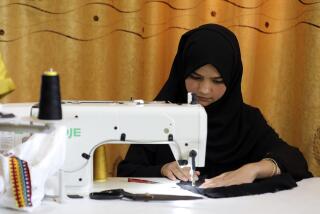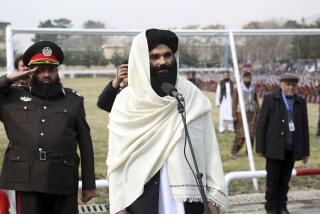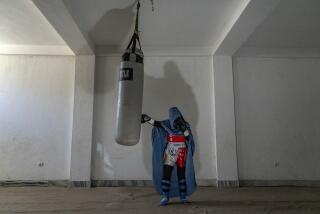A Future Shaped by Hope
- Share via
KABUL, Afghanistan — Twelve months ago, when she heard that terrorists had slammed planes into the World Trade Center, Jamila Omar had no idea that her own world, thousands of miles away, would change for the better. Like most Afghans, she was filled with dread--fearful of facing another long war, fearful that she or people she loved would be killed.
For the five years of Taliban rule, she dared not emerge from her home without the all-encompassing robin’s-egg-blue burka. On the bus, like other women, the college-educated journalist took her place at the rear. She saw stretching ahead of her a life only half-lived.
“I had concluded,” she said, “that we women would always remain in the corners of the room.”
A year later, however, women are working and going to school. A government that is representative has been formed. Except for pockets of U.S. military activity against Al Qaeda and Taliban suspects--and despite an assassination attempt last week against President Hamid Karzai--more than two decades of civil war appear to have ended.
The list goes on: International aid money is beginning to pour in, albeit not as quickly as people would like, and foreign organizations are offering advice and personnel. Institutions are forming. Newspapers are being published in relative freedom. The national airline, Ariana, has taken wing again. Refugees are returning to their homes by the hundreds of thousands, exceeding all estimates. National army and police forces are in training, and mine clearers are working full time to purge roads and fields of the deadly explosives.
The country has in Karzai a moderate leader who inspires confidence in the West and affection from most of his people--even if he’s something of a figurehead with limited powers outside this capital city. Mohammad Zaher Shah, the octogenarian former king, has returned and moved back into his old palace. Although no longer a monarch, he has been given the honorific title “Father of the Nation.”
And in the last few weeks of summer, women such as Omar have found the courage to shed their burkas and walk with the sun on their faces, at least here in Kabul.
“The changes we have witnessed are changes we never even dreamed of in the past,” said Omar, 30, now a reporter for the Kabul Weekly, a newspaper that strives for Western standards of objectivity in English, Dari and Pashto. “To begin with, I can tell you about women: They have not only been physically freed ... but they have been mentally released.”
Of course, there are worries on the horizon, made all the more plain by the twin shocks of nearly losing Karzai to an assassin’s bullet in the former Taliban stronghold of Kandahar and the horror of a bombing that mowed down 26 people in Kabul. On the eve of the first anniversary of the Sept. 11 attacks blamed on Osama bin Laden’s Al Qaeda terrorist network, the latest acts appeared to be a coordinated challenge to the new Afghan order.
There are still deep fault lines in the society--disagreement over how liberal a government Afghanistan can afford while many of its people remain deeply conservative. And many here still fear what could happen to the country if Western interest flags because of a war in Iraq or simple boredom. Afghans express anxiety that the “commanders”--a euphemism for the country’s regional warlords--have not been effectively disarmed and are still playing too large a role.
Although governors are appointed and are supposed to follow directions from the central government, a lack of rudimentary telecommunications and a deteriorated road network make it difficult for officials in Kabul to know what is happening in the regions, much less impose authority.
Powerful commanders such as Abdul Rashid Dostum in the northern city of Mazar-i-Sharif and Ismail Khan in the western province of Herat are able to rule as virtual potentates in their regions, collecting customs revenues without remitting them to Kabul, while at the same time paying lip service to Karzai’s government.
Despite all this, in big cities and small villages alike throughout Afghanistan, one encounters an almost uniform sense of hope that this blood-soaked country has made a worthy start toward becoming a united and peaceful state. For many ordinary Afghans, the quality of life hasn’t markedly improved, making their optimism even more poignant.
On the banks of the muddy Amu Darya River, facing Uzbekistan on the northern frontier of Afghanistan, a 19-year-old high school student called Najibullah might have cause for complaint. Thin and ill-clothed, he is living in a warren of hovels made of abandoned steel containers, and his family draws water from the polluted river because there is no other source nearby.
But instead of complaints, he spoke enthusiastically of where his country is headed, and his plans to be part of it.
“We are optimistic that our country has retreated from military conflicts and now it can become better and better, and that the reconstruction will continue,” he said, adding that his dream is to be an engineer when he finishes his education. “We are all thinking in this way, and we are trying our best to help.”
What has seized Afghanistan--a phenomenon that might not be discernible amid the daily news items about conflicts, military actions and the hunt for Bin Laden--seems to be a national hunger to make up for the last 23 years.
The spirit can be felt especially in Kabul.
Its streets are crowded as never before. Of the 1.6 million refugees who have poured back into the country, more than half a million have resettled in the capital, swelling its population to 2.5 million.
There is a scarcity of housing, garbage collection, electric power and, because of drought, clean water. Yet the city hums and bustles. Returning to it after an absence of six months, one is struck by how busy everyone seems. The streets are congested with all manner of conveyances--yellow-and-white taxis, Chinese-made bicycles with rainbow reflectors on their wheels, pushcarts, donkey carts, even the occasional horse and buggy or a team of boy-driven buffalo--doomed to be slaughtered on Butcher’s Street.
Everybody is selling something. Restaurants have begun to sprout up. Although the city retains its cluttered, dusty, war-scarred face, some of the vehicles on the street are new, like the 50 modern buses donated by India, the green-and-white police vans sent by Germany, and the platoons of gleaming white Land Cruisers used by the United Nations and the more affluent nongovernmental organizations.
There is also a frequent parade of military vehicles, trucks and armored personnel carriers mounted by jaunty-looking French, German, Italian or Turkish peacekeepers wearing cool-warrior sunglasses and bandannas around their necks.
In most of the ministries, too, work is starting to get done. Side by side, men and women plan their programs and reforms, often accompanied by small teams of foreign advisors, helping to jump-start civil aviation, the Central Bank, the phone system.
Enough government functionaries are back on the job that at 4 p.m., the official quitting time, streets suddenly become jammed. A real rush hour has returned to the city.
Yet a recent Friday at the Haji Yakub mosque, the city’s main place of worship, the thunderous sermon might have raised doubts about whether the Taliban had ever left town.
“Our nation now needs water and bread, not songs and women’s music on the radio!” exclaimed the imam, Kefayatullah Badakhshani. “Each one of us has a responsibility to struggle against adultery, sex and injustice in the country.”
In another passage, he said, “This is supposed to be an Islamic government, and an Islamic government is required to apply Islamic rule. In this country, there has been war and destruction for 23 years. It is a tragedy now that many Afghans do not have shelter, do not have a morsel of food. Does such a nation need food and shelter, or does it need television, films and music?”
One day after the sermon, the Supreme Court of Afghanistan backed a decision by the head of Kabul Radio and Television to ban women from singing on the radio and to prevent Indian films from being aired in the capital.
“We totally oppose the idea of half-naked scenes or ... women’s songs being aired,” Fazl Ahmad Manawi, deputy head of the court, told a reporter. A separate commission appointed by Karzai to monitor broadcast media, however, said the action was without legal basis.
The controversy was seen here as a way to stake out political positions for upcoming elections planned in two years. Although there are no official political parties in Afghanistan, de facto factions are vying within the ruling group that came to power.
A top government official, speaking on condition of anonymity, deplored the court’s ruling and the action of the religiously conservative director of Kabul Radio and Television.
“Afghanistan has a long tradition of watching Indian movies, for at least half a century. For a court to want to change this now, in this manner, is not the most intelligent thing one could do,” he said. “It stems from a certain amount of ignorance, as well as a demarcation of the future political battleground between more fundamentalist groups and more liberal groups.
“This is part of nation-building, because issues like this come up and it is necessary to address them--and hopefully not with guns.”
Mohammed Fahim Dashty had even more reason than most to be bereft of hope last September when the World Trade Center and the Pentagon were attacked. He had suffered severe burns, and was in the process of being evacuated to France, after surviving a Sept. 9 bombing that claimed the life of Ahmed Shah Masoud, leader of the Northern Alliance that then was the last resistance to Taliban rule.
Dashty was filming a documentary of Masoud and was sitting behind him when the assassins struck.
He spent more than two months recuperating in Paris, and the collapse of the Taliban gave him an opportunity to return to Kabul. Dashty, who still bears the scars of his injuries, became the editor who reestablished the Kabul Weekly after the Taliban fell. He is now a prominent journalist.
Looking at the past year, he identifies as the most important achievement the holding of the loya jirga, the grand council that chose a new leadership for the country. And the most serious challenge for the nation, he believes, is overcoming its lingering ethnic divisions.
“The meeting of all ethnic groups, all the political groups, in one tent, lasting eight days, and everyone being able to say what they wanted--this was a good exercise for us to start over in unity. The other [positive] factor is the cooperation of the international community, economically and militarily.”
But Dashty said he is angered by the way some of the money earmarked for Afghanistan is being spent by foreign organizations. “It’s crazy,” he said. “They are buying the latest-model cars for $40,000 each, [which is] the salaries of 10 ministers of the Afghan government. If we are to succeed in our recovery, we need that money more than they do.”
At the Finance Ministry, where former Johns Hopkins University professor Ashraf Ghani is trying to set a firm fiscal course, the matter of foreign aid is also pressing. Ghani sees the fulfillment of the pledges of assistance made in Tokyo by donor countries in January as the catalyst for reviving a moribund economy. Development projects will create jobs and serve as a magnet for foreign investment, which will bring additional capital and know-how into the country.
But for now, Ghani is worried that even his modest $460-million government budget for the year may have to be scaled back if the pledges don’t come through.
Ghani refused to be drawn into criticizing the donor governments, however, saying he understands how slowly the appropriation process works in various countries.
He believes that the pledges were made in good faith and will eventually be honored.
“We have been bombed, we have been invaded, but now is the time for us--with the international community as partners with us,” he said.
Remarkably quickly, the extremism of the past is fading into anecdotes. Dr. Fahima Sekandari Khalil, the de facto head of the country’s only maternity hospital during the Taliban years, recalls the ever-present fear she felt when out in public, like a remembered rap on her hand when she accidentally exposed her wrist pointing to an object in the bazaar.
She was a rare woman who was allowed to work--partly because she was always being drafted to tend to the wives of Taliban officials. When it was time to go home, she had to draft one of the hospital janitors to be her escort so she would not be abused by the religious police.
Today, she has the pleasure of sitting in her own office, managing the hospital in her own right, and laughing at some of the sillier edicts that came down from the Taliban religious authorities: Nurses should not dress in clean, ironed white smocks, only dingy, wrinkled ones; patients who were beautifully made up should be denied medical treatment; nail polish was strictly forbidden.
“Already now it seems funny,” she said, “but at that time it was terribly difficult. Yes, it was difficult.”
More to Read
Sign up for Essential California
The most important California stories and recommendations in your inbox every morning.
You may occasionally receive promotional content from the Los Angeles Times.










